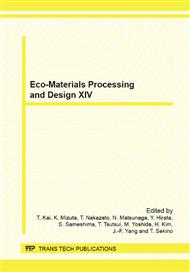p.15
p.19
p.23
p.27
p.35
p.41
p.49
p.55
p.59
Nitrogen Doping to Metatitanic Acid by NH3 Heat Treatment for Achieving Visible-Light-Responsive Photocatalytic Activity
Abstract:
Nitrogen doping can be achieved by heating TiO2-based photocatalyst powders under dopant-generating atmospheres such as NH3. In the present work, metatitanic acid (MTA) powder was used as a raw material to obtain nitrogen-doped titania using heat treatment in NH3 flow. MTA is an industrially available intermediate product in sulfate process for TiO2 production, which is mesoporous material with high specific surface area. The MTA powder was heat-treated in flowing NH3 at 400–550°C. For comparison, commercial P25 TiO2 powder was heat-treated under the same conditions. The results show that nitrogen dopant can be successfully incorporated into the MTA by heating in NH3 atmosphere. This obviously results in the enhanced visible-light photocatalytic activity, especially in MTA sample heated at 400°C. Due to the fascinating properties of MTA powder such as high specific surface area, the N-doping effect on MTA powder is much higher than the P25 TiO2 powder.
Info:
Periodical:
Pages:
35-39
Citation:
Online since:
July 2013
Authors:
Keywords:
Price:
Сopyright:
© 2013 Trans Tech Publications Ltd. All Rights Reserved
Share:
Citation:


